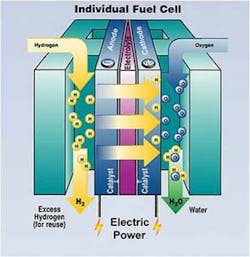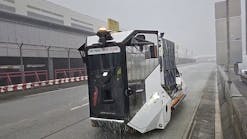Cargo/Baggage Handling Equipment: Batteries Evolve for Electric GSE
The argument for electric ground support equipment is pretty strong. The cost of the electricity to power a vehicle is about 25 percent of the cost of diesel fuel. And the total carbon footprint of the electric vehicle is about 15 percent of its diesel counterpart. This is why there has been so much attention given to electric vehicles and why they have become increasingly more common on the ramp, largely in the form of bag tugs and belt loaders. Ironically, not much attention has been given to the device that actually produces the electricity — the battery.
Today’s modern electric ground support equipment is typically powered by a lead-acid battery — a battery invented in the 1859. In simple terms, a lead-acid battery creates a chemical reaction between lead oxide and sulfuric acid to produce lead sulfate and electricity. That electricity then powers the vehicle’s electric motor. The process is then reversed, returning the battery to its original fully charged state. A high-quality, well-maintained battery can last well over five years and 1800 charge cycles.
Lead-acid: It’s Come a Long Way
Let’s give the lead-acid battery some credit. It’s the original rechargeable battery and it still today delivers the most power per dollar of any other battery technology. Fortunately, it has come a long way in the last 150 years and there are many variations and options:
Flat-plate batteries are the standard duty battery. They are the most economical of all the batteries and provide good performance and life.
Sealed “maintenance-free” batteries do not require water. They use a gelled electrolyte or sometimes a glass mat to absorb the electrolyte. This prevents the battery from losing hydrogen and oxygen during the charging process, and therefore eliminates the need to add water. However, they have a huge downside — they can cost twice as much and last half as long as a comparable “flooded” battery.
Tubular batteries use a tubular-shaped plate to create more surface area for the chemical reaction to take place. This provides more total power and better vehicle performance. These batteries also tend to provide better throughput and cycle life.
High-capacity batteries provide even more power in the same cubic space. This is a great choice for heavy-duty applications where a bigger “gas tank” is needed for higher-power consumption or longer run times. These batteries are not cheap. There is more cost for more kwh’s and often the price per kwh is higher, too.
Low-maintenance batteries require less-frequent watering. Labor savings can be significant, reducing the number of waterings from 50 times per year to 12, or even six times per year. Watering is the most important part of maintaining a battery, so making sure the battery always has sufficient water is critical. Anticipate longer life because the risk of damage from under-watering is minimized. This is a great choice for GSE.
Fast-charge batteries are built to handle the added current and heat generated by a fast-charging application. Typically, the battery’s conductors, such as cables and inter-cell connectors, are larger and the steel tray is vented for cooling airflow. These batteries may cost more or may have less power capacity, but they could be necessary. Too much heat kills a battery just like too little water.
Add-on Options
In addition to choices of battery technology are choices of add-on options. Some are as simple and inexpensive as flip-top vent caps instead of the standard quarter-turn caps, or a water de-ionizer to filter out impurities. (The basic rule of thumb: If the water is good enough for a human, it’s good enough for a battery.)
Single-point watering system: This is a highly recommended option. The device installs on the battery and provides a single quick-connect fitting that plugs into your water supply. This allows a user to fill a battery in one minute instead of 30 minutes, and water each cell to exactly the perfect level. With proper watering being the most important thing maintenance personnel can do, this system should be on every battery.
Battery data module: This is a device that monitors and stores all the activity related to the battery, such as temperature, state of charge, number of charge cycles, power throughput, and time of charge and discharge. They’re typically a part of any fast-charging system, but a powerful tool on their own. They’re invaluable for diagnosing problems and managing the fleet, and ultimately improving performance, improving battery life and saving money.
The Future of GSE Battery Technology
For all the advantages of lead-acid, there are some significant drawbacks. Lead-acid batteries are full of hazardous material, require frequent maintenance, and can take a long time to recharge. For these reasons, there’s a good chance a new technology is going to finally replace the old. There are more possibilities that can be noted here, but below are some good prospects.
The first prospect is an upgraded version of lead-acid battery called thin plate pure lead (tppl), which is exactly what it sounds like. The plates are so thin they behave like spaghetti during the manufacturing process. Its main benefits are power density and ultra-fast recharge time, and that it’s maintenance free. This could be the transitional step away from lead-acid, particularly for GSE since the industry has already adopted fast-charge technology. Tppl, which may be familiar, is found in the Odyssey brand battery.
The second prospect is the Lithium-Ion battery, which has already become the dominant technology for cell phone, laptops and on-road electric vehicles. Its main benefits are power density, light weight, and that it’s also maintenance free. The benefits to GSE may never outweigh the cost, but with so many new Li-ion manufacturing plants ramping up for electric cars, one never can tell.
The big story in electric vehicle technology is fuel cells. A fuel cell uses a gas, such as hydrogen, as a kind of fuel to create electricity. The only emission from a hydrogen fuel cell is water and there is no “recharge” necessary. A user will still have to “fill up” the tank when it’s empty, but that should only take a few minutes. Of course, an operator would have to find a hydrogen-fuel station, but that’s another issue. There are many competing technologies within fuel cells. Hydrogen is clearly the most popular, but pay attention to methanol fuels cells as well — they may be a faster path to widespread adoption.
All of these new technologies will be viable. In fact, they are all powering vehicles today. And in all probability, the price will eventually drop enough to compete with today’s lead-acid battery. The question is: Which one will be the dominant technology for GSE?






